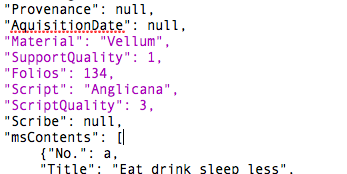Talking about touching parchment, this week’s code blog is all about how to add touch data to our JSON descriptions of manuscripts right now, before parchment surface experimentation is perfected (watch this space, it might happen).
I’ve chosen to use Oxford, Bodleian Library MS Laud Misc. 656 for this particular endeavor because it has some really fascinating, really feature-rich, really bad parchment. And, bad parchment is really the best, because you can see and touch so many features of it. Unlike really high quality parchment, which has eradicated so many of its distinguishing features that it makes you forget–however momentarily–that it is skin, bad parchment carries reminders of what it was, where it came from, marks of class and production, and so much more.
So, this blog is about capturing that kind of awesome badness in code. Now, the code to date has a few features that allow me to talk about this thing that fascinates me (the touch of parchment):






